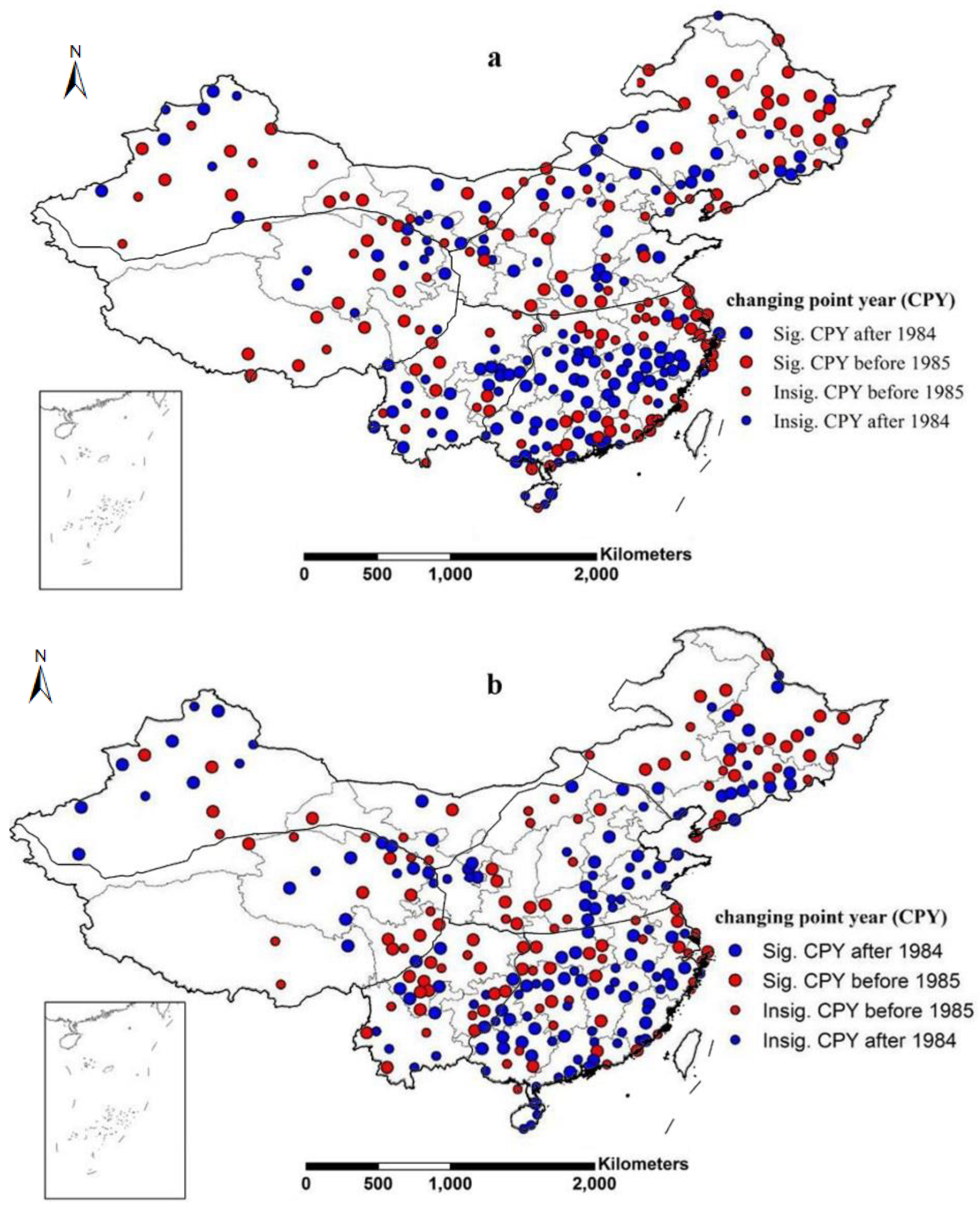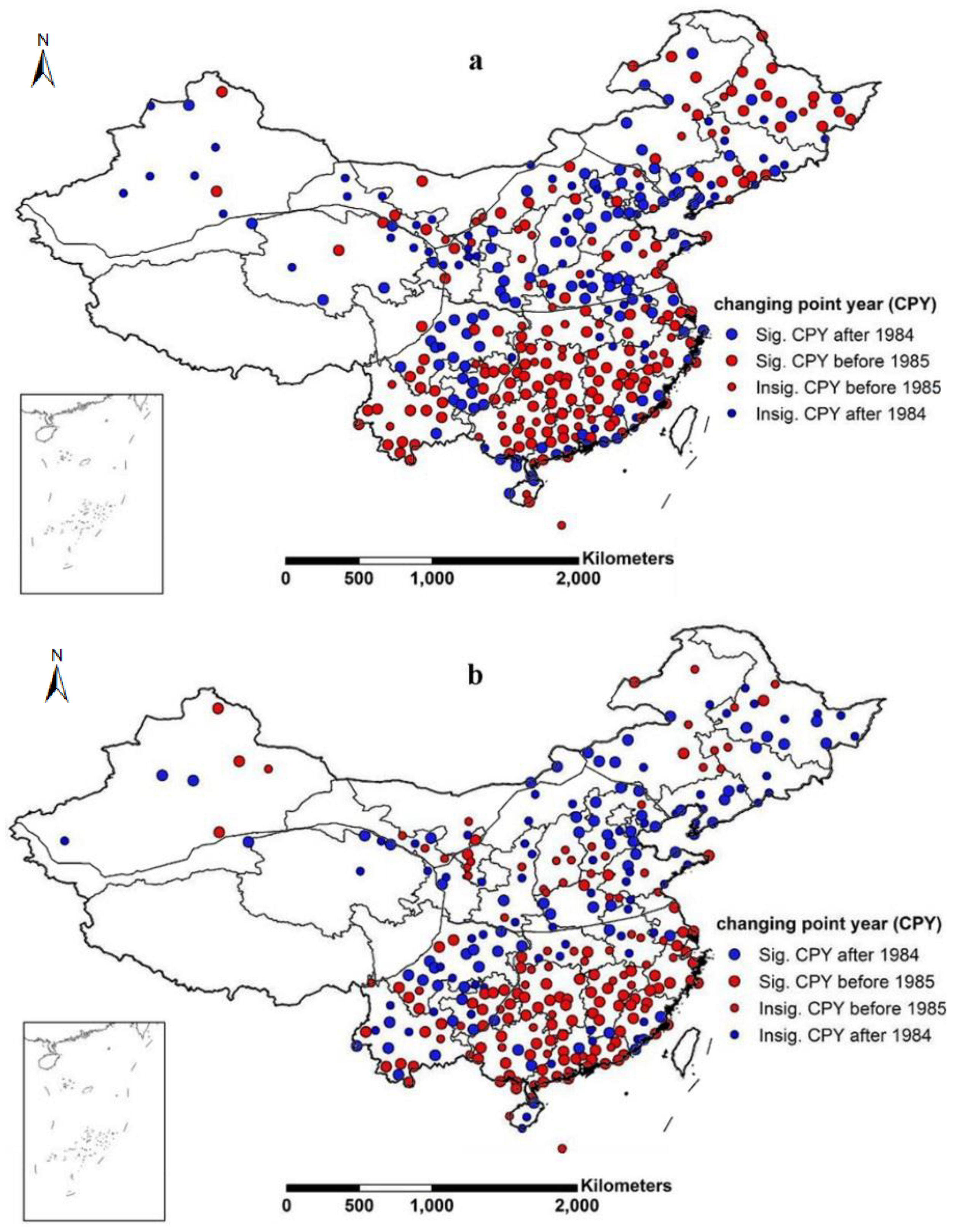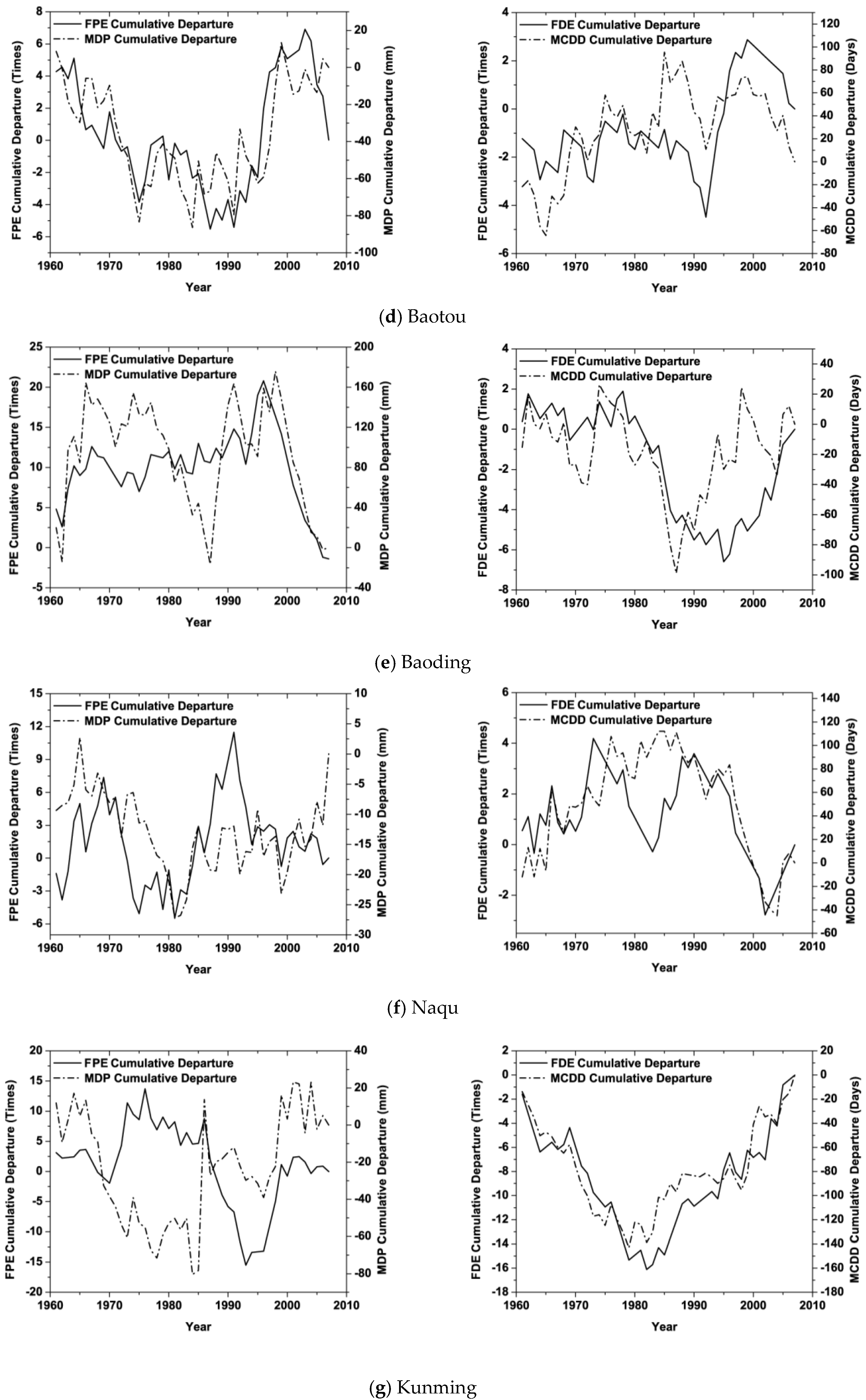Change-Point Analysis of Precipitation and Drought Extremes in China over the Past 50 Years
Abstract
:1. Introduction
2. Data and Methods
2.1. Study Area and Data
2.2. Methods
2.2.1. Thresholds of Precipitation and Drought Extremes
2.2.2. Change-Point Analysis
2.2.3. Cumulative Deviation Analysis
3. Results
3.1. Spatial Distribution of Change-Point Years of Increasing Precipitation Extremes
3.2. Spatial Distribution of Change-Point Years of Increasing Drought Extremes
3.3. Temporal Changes of PE and DE at the Typical Stations of the Regions
4. Discussion
5. Conclusions
Author Contributions
Funding
Acknowledgments
Conflicts of Interest
References
- Field, C.B.; Barros, V.; Stocker, T.F.; Qin, D.; Dokken, D.J.; Ebi, K.L.; Mastrandrea, M.D.; Mach, K.J.; Plattner, G.K. Special report on managing the risks of extreme events and disasters to advance climate change adaptation (SREX). J. Epidemiol. Community Health 2012, 66, 759. [Google Scholar]
- Stocker, T.F.; Qin, D.; Plattner, G.K.; Tignor, M.; Allen, S.K.; Boschung, J.; Nauels, A.; Xia, Y.; Bex, V.; Midgley, P.M. Climate Change 2013: The Physical Science Basis. Contribution of Working Group I to the Fifth Assessment Report of the Intergovernmental Panel on Climate Change; Cambridge University Press: Cambridge, UK; New York, NY, USA, 2013. [Google Scholar]
- Seneviratne, S.I.; Nicholls, N.; Easterling, D.; Goodess, C.M.; Kanae, S.; Kossin, J.; Luo, Y.; Marengo, J.; Mcinnes, K.; Rahimi, M. Changes in Climate Extremes and Their Impacts on the Natural Physical Environment: An Overview of the IPCC SREX Report; Cambridge University Press: Cambridge, UK; New York, NY, USA, 2012. [Google Scholar]
- Nicholls, N. Long-term climate monitoring and extreme events. Clim. Chang. 1995, 31, 231–245. [Google Scholar] [CrossRef]
- Frei, C.; Schär, C. Detection probability of trends in rare events: Theory and application to heavy precipitation in the Alpine region. J. Clim. 1999, 14, 1568–1584. [Google Scholar] [CrossRef]
- Zhai, P.; Sun, A.; Ren, F.; Liu, X.; Bo, G.; Qiang, Z. Changes of Climate Extremes in China. Clim. Chang. 1999, 42, 203–218. [Google Scholar] [CrossRef]
- Frich, P.; Alexander, L.V.; Della-Marta, P.; Gleason, B.; Haylock, M.; Klein Tank, A.; Peterson, T. Observed coherent changes in climatic extremes during the second half of the twentieth century. Clim. Res. 2002, 19, 193–212. [Google Scholar] [CrossRef] [Green Version]
- Alexander, L.V.; Zhang, X.B.; Peterson, T.C.; Caesar, J.; Gleason, B.A.; Tank, A.; Haylock, M.; Collins, D.; Trewin, B.; Rahimzadeh, F. Global observed changes in daily climate extremes of temperature and precipitation. J. Geophys. Res. Atmos. 2006, 111, 1042–1063. [Google Scholar] [CrossRef] [Green Version]
- Nastos, P.T.; Zerefos, C.S. Spatial and temporal variability of consecutive dry and wet days in Greece. Atmos. Res. 2009, 94, 616–628. [Google Scholar] [CrossRef]
- Re, M.; Barros, V.R. Extreme rainfalls in SE South America. Clim. Chang. 2009, 96, 119–136. [Google Scholar] [CrossRef]
- Mittal, N.; Mishra, A.; Singh, R. Combining climatological and participatory approaches for assessing changes in extreme climatic indices at regional scale. Clim. Chang. 2013, 119, 603–615. [Google Scholar] [CrossRef]
- Hawcroft, M.; Walsh, E.; Hodges, K.; Zappa, G. Significantly increased extreme precipitation expected in Europe and North America from extratropical cyclones. Environ. Res. Lett. 2018, 13, 124006. [Google Scholar] [CrossRef]
- Tabari, H.; Willems, P. More prolonged droughts by the end of the century in the Middle East. Environ. Res. Lett. 2018, 13, 104005. [Google Scholar] [CrossRef] [Green Version]
- Wang, Y.; Xu, Y.; Tabari, H.; Wang, J.; Wang, Q.; Song, S.; Hu, Z. Innovative trend analysis of annual and seasonal rainfall in the Yangtze River Delta, eastern China. Atmos. Res. 2020, 231, 104673. [Google Scholar] [CrossRef]
- Mason, S.J.; Waylen, P.R.; Mimmack, G.M.; Rajaratnam, B.; Harrison, J.M. Changes in Extreme Rainfall Events in South Africa. Clim. Chang. 1999, 41, 249–257. [Google Scholar] [CrossRef]
- Klein Tank, A.M.G.; Können, G.P. Trends in Indices of Daily Temperature and Precipitation Extremes in Europe, 1946–99. J. Clim. 2002, 16, 3665–3680. [Google Scholar] [CrossRef]
- Zhai, P.; Zhang, X.; Wan, H.; Pan, X. Trends in total precipitation and frequency of daily precipitation extremes over china. J. Clim. 2005, 18, 1096–1108. [Google Scholar] [CrossRef]
- Figdor, E. When It Rains, It Pours: Global Warming and the Rising Frequency of Extreme Precipitation in the United States; Environment America Research and Policy Center: Boston, MA, USA, 2007. [Google Scholar]
- Yao, C.; Qian, W.; Yang, S.; Lin, Z. Regional features of precipitation over Asia and summer extreme precipitation over Southeast Asia and their associations with atmospheric—Oceanic conditions. Meteorol. Atmos. Phys. 2010, 106, 57–73. [Google Scholar] [CrossRef]
- Boccolari, M.; Malmusi, S. Changes in temperature and precipitation extremes observed in Modena, Italy. Atmos. Res. 2013, 122, 16–31. [Google Scholar] [CrossRef]
- Long, D.; Scanlon, B.R.; Fernando, D.N.; Meng, L.; Quiring, S.M. Are Temperature and Precipitation Extremes Increasing over the U.S. High Plains? Earth Interact. 2015, 16, 1–20. [Google Scholar] [CrossRef]
- Croitoru, A.E.; Piticar, A.; Burada, D.C. Changes in precipitation extremes in Romania. Georev. Sci. Ann. Stefan Cel Mare Univ. Suceava Geogr. 2016, 415, 325–335. [Google Scholar] [CrossRef]
- Alexander, L.V. Global observed long-term changes in temperature and precipitation extremes: A review of progress and limitations in IPCC assessments and beyond. Weather Clim. Extrem. 2016, 11, 4–16. [Google Scholar] [CrossRef] [Green Version]
- Gong, D.Y.; Shi, P.J.; Wang, J.A. Daily precipitation changes in the semi-arid region over northern China. J. Arid Environ. 2004, 59, 771–784. [Google Scholar] [CrossRef]
- Heberger, M. Australia’s Millennium Drought: Impacts and Responses; Island Press: Washington, DC, USA, 2012. [Google Scholar]
- Dijk, A.I.J.M.; Beck, H.E.; Crosbie, R.S.; Jeu, R.A.M.D.; Liu, Y.Y.; Podger, G.M.; Timbal, B.; Viney, N.R. The Millennium Drought in southeast Australia (2001–2009): Natural and human causes and implications for water resources, ecosystems, economy, and society. Water Resour. Res. 2013, 49, 1040–1057. [Google Scholar] [CrossRef]
- Wu, J.; Chen, X. Spatiotemporal trends of dryness/wetness duration and severity: The respective contribution of precipitation and temperature. Atmos. Res. 2019, 216, 176–185. [Google Scholar] [CrossRef]
- Mitchell, D.; Achutarao, K.; Allen, M.; Bethke, I.; Zaaboul, R. Half a degree additional warming, prognosis and projected impacts (HAPPI): Background and experimental design. Geosci. Model Dev. 2017, 10, 571–583. [Google Scholar] [CrossRef] [Green Version]
- Allen, M.R.; Dube, O.P.; Solecki, W.; Aragón-Durand, F.; Cramer, W.; Humphreys, S.; Kainuma, M.; Kala, J.; Mahowald, N.; Mulugetta, Y.; et al. Framing and Context. In Global Warming of 1.5 °C. An IPCC Special Report on the Impacts of Global Warming of 1.5 °C above Pre-industrial Levels and Related Global Greenhouse Gas Emission Pathways, in the Context of Strengthening the Global Response to the Threat of Climate Change; Masson-Delmotte, V., Zhai, P., Pörtner, H.-O., Roberts, D., Skea, J., Shukla, P.R., Pirani, A., Moufouma-Okia, W., Péan, C., Pidcock, R., et al., Eds.; World Meterological Organization: Geneva, Switzerland, 2018; p. 46. [Google Scholar]
- Su, B.; Gemmer, M.; Jiang, T. Spatial and temporal variation of extreme precipitation over the Yangtze River Basin. Quat. Int. 2008, 186, 22–31. [Google Scholar] [CrossRef]
- Ning, L.; Qian, Y. Interdecadal Change in Extreme Precipitation over South China and its Mechanism. Adv. Atmos. Sci. 2009, 26, 109–118. [Google Scholar] [CrossRef]
- Wang, Z.; Qian, Y. Frequency and intensity of extreme precipitation events in China. Adv. Water Sci. 2009, 20, 1–9. [Google Scholar]
- Li, Z.; Zheng, F.; Liu, W. Spatial distribution and temporal trends of extreme temperature and precipitation events on the Loess Plateau of China during 1961–2007. Quat. Int. 2010, 226, 92–100. [Google Scholar] [CrossRef]
- Wang, X.; Hou, X.; Wang, Y. Spatiotemporal variations and regional differences of extreme precipitation events in the Coastal area of China from 1961 to 2014. Atmos. Res. 2017, 197, 94–104. [Google Scholar] [CrossRef]
- Tong, S.; Li, X.; Zhang, J.; Bao, Y.; Bao, Y.; Na, L.; Si, A. Spatial and temporal variability in extreme temperature and precipitation events in Inner Mongolia (China) during 1960–2017. Sci. Total Environ. 2019, 649, 75–89. [Google Scholar] [CrossRef]
- Liu, M.; Shen, Y.; Qi, Y.; Wang, Y.; Geng, X. Changes in Precipitation and Drought Extremes over the Past Half Century in China. Atmosphere 2019, 10, 203. [Google Scholar] [CrossRef] [Green Version]
- Viglizzo, E.F.; Roberto, Z.E.; Filippin, M.C.; Pordomingo, A.J. Climate variability and agroecological change in the Central Pampas of Argentina. Agric. Ecosyst. Environ. 1995, 55, 7–16. [Google Scholar] [CrossRef]
- Plummer, N.; Salinger, M.J.; Nicholls, N.; Suppiah, R.; Hennessy, K.J.; Leighton, R.M.; Trewin, B.; Page, C.M.; Lough, J.M. Changes in Climate Extremes Over the Australian Region and New Zealand During the Twentieth Century. Clim. Chang. 1999, 42, 183–202. [Google Scholar] [CrossRef]
- Ning, Z.; Yoon, J.H.; Marengo, J.A.; Subramaniam, A.; Nobre, C.A.; Mariotti, A.; Neelin, J.D. Causes and impacts of the 2005 Amazon drought. Environ. Res. Lett. 2008, 3, 14002. [Google Scholar]
- Lewis, S.L.; Brando, P.M.; Phillips, O.L.; Heijden, G.M.F.V.; Nepstad, D. The 2010 Amazon Drought. Science 2011, 331, 554. [Google Scholar] [CrossRef]
- Cardoso Pereira, S.; Marta Almeida, M.; Carvalho, A.C.; Rocha, A. Extreme precipitation events under climate change in the Iberian Peninsula. Int. J. Climatol. 2019. [Google Scholar] [CrossRef]
- Hoegh-Guldberg, O.; Jacob, D.; Taylor, M.; Bindi, M.; Brown, S.; Camilloni, I.; Diedhiou, A.; Djalante, R.; Ebi, K.L.; Engelbrecht, F.; et al. Impacts of 1.5 °C Global Warming on Natural and Human Systems. In Global Warming of 1.5 °C. An IPCC Special Report on the Impacts of Global Warming of 1.5 °C above Pre-industrial Levels and Related Global Greenhouse Gas Emission Pathways, in the Context of Strengthening the Global Response to the Threat of Climate Change; Masson-Delmotte, V., Zhai, P., Pörtner, H.-O., Roberts, D., Skea, J., Shukla, P.R., Pirani, A., Moufouma-Okia, W., Péan, C., Pidcock, R., et al., Eds.; World Meterological Organization: Geneva, Switzerland, 2018; p. 138. [Google Scholar]
- Liu, X. Climatic Characteristic of Extreme Rainstorm Events in China. J. Catastrophol. 1999, 42, 203–218. [Google Scholar]
- Gong, D.Y.; Wang, J.A.; Han, H. Trends of summer dry spells in China during the late twentieth century. Meteorol. Atmos. Phys. 2005, 88, 203–214. [Google Scholar] [CrossRef]
- Yang, J.H.; Jiang, Z.H.; Wang, P.X. Temporal and Spatial Characteristic of Extreme Precipitation Event in China. Clim. Environ. Res. 2008, 13, 75–83. [Google Scholar]
- Li, Z.; He, Y.; Wang, C.; Wang, X.; Xin, H.; Wei, Z.; Cao, W. Spatial and temporal trends of temperature and precipitation during 1960–2008 at the Hengduan Mountains, China. Quat. Int. 2011, 236, 127–142. [Google Scholar] [CrossRef]
- Fu, G.; Yu, J.; Yu, X.; Ouyang, R.; Zhang, Y.; Wang, P.; Liu, W.; Min, L. Temporal variation of extreme rainfall events in China, 1961–2009. J. Hydrol. 2013, 487, 48–59. [Google Scholar] [CrossRef]
- Wang, B.; Zhang, M.; Wei, J.; Wang, S.; Li, X.; Li, S.; Zhao, A.; Li, X.; Fan, J. Changes in extreme precipitation over Northeast China, 1960–2011. Quat. Int. 2013, 298, 177–186. [Google Scholar] [CrossRef]
- Liang, F.; Liu, D.; Wang, W.; Zhang, F.; Yu, F. Temporal and spatial variability of summer extreme precipitation events in Northeast China during 1961–2013. Arid Land Geogr. 2016, 39, 565–572. [Google Scholar]
- Liu, M.; Shen, Y.; Yan, Z.; Liu, C. Trend in pan evaporation and its attribution over the past 50 years in China. J. Geogr. Sci. 2010, 20, 557–568. [Google Scholar] [CrossRef]
- Shen, Y.J.; Liu, C.M.; Liu, M.; Zeng, Y.; Tian, C.Y.; Liu, C.M.; Chen, Y.N.; Xu, Z.X. Change in pan evaporation over the past 50 years in the arid region of China. Hydrol. Process 2010, 24, 225–231. [Google Scholar] [CrossRef]
- Brown, L. The Conditional Level of Student’s t Test. Ann. Math. Stat. 1967, 38, 1068–1071. [Google Scholar] [CrossRef]
- Xu, L.; Guo, Y.; Liu, M.; Hu, Q.; Chen, F.; Yang, S.; Shen, Y. Analysis of Temperature Trends and Change Points in the Haihe River Basin Over the Last 50 Years. Resour. Sci. 2011, 33, 995–1001. [Google Scholar]
- Lin, Y.; Lye, L.M. Modelling long-term dependence based on cumulative departures of annual flow series. J. Hydrol. 1994, 160, 105–121. [Google Scholar] [CrossRef]
- Feng, X.; Luo, L.; Feng, Z.; Liu, P.; Qiu, L. Fractal research on rainy day change trend in China. J. Nat. Disasters 2009, 18, 112–117. [Google Scholar]
- Siebert, S.; Burke, J.; Faures, J.M.; Frenken, K.; Hoogeveen, J.; Döll, P.; Portmann, F.T. Groundwater use for irrigation—A global inventory. Hydrol. Earth Syst. Sci. 2010, 14, 1863–1880. [Google Scholar] [CrossRef] [Green Version]






| Regions | No. of Stations | Frequency of Precipitation Extreme | Intensity of Precipitation Extreme | ||
|---|---|---|---|---|---|
| Increase CPY (%) | Sig. Increase CPY (%) | Increase CPY (%) | Sig. Increase CPY (%) | ||
| NE | 98 | 49.0 | 68.8 | 49.0 | 64.6 |
| NC | 97 | 43.3 | 54.8 | 43.3 | 52.4 |
| SE | 154 | 70.8 | 63.3 | 60.4 | 51.6 |
| SW | 56 | 60.7 | 58.8 | 58.9 | 66.7 |
| QT | 43 | 69.8 | 53.3 | 60.5 | 61.5 |
| NW | 52 | 69.2 | 55.6 | 38.5 | 65.0 |
| China | 500 | 59.8 | 60.5 | 52.6 | 58.0 |
| Regions | No. of Stations | Frequency of Drought Extreme | Intensity of Drought Extreme | ||
|---|---|---|---|---|---|
| Increase CPY (%) | Sig. Increase CPY (%) | Increase CPY (%) | Sig. Increase CPY (%) | ||
| NE | 98 | 62.2 | 68.9 | 44.9 | 43.2 |
| NC | 97 | 84.5 | 61.0 | 66.0 | 39.1 |
| SE | 154 | 87.0 | 72.4 | 81.2 | 68.0 |
| SW | 56 | 89.3 | 82.0 | 94.6 | 73.6 |
| QT | 43 | 25.6 | 72.7 | 11.6 | 60.0 |
| NW | 52 | 40.4 | 28.6 | 32.7 | 52.9 |
| China | 500 | 71.8 | 68.0 | 61.6 | 58.4 |
| Representative Stations | FPE | IPE | FDE | IDE | ||||
|---|---|---|---|---|---|---|---|---|
| T | CPY | T | CPY | T | CPY | T | CPY | |
| Harbin | −2.12 | 1976 | −2.11 | 1979 | −1.26 | 1996 | −1.73 | 1995 |
| Urumqi | −3.29 | 1975 | −2.15 | 1977 | −1.00 | 1994 | 1.57 | 1991 |
| Zhangye | −1.67 | 1970 | −1.41 | 1982 | −3.18 | 1978 | −1.12 | 1972 |
| Baotou | −1.86 | 1991 | −1.25 | 1976 | −2.13 | 1992 | 1.21 | 1975 |
| Baoding | 3.32 | 1997 | −2.09 | 1987 | −2.28 | 1996 | −2.19 | 1987 |
| Naqu | 2.09 | 1991 | −1.53 | 1982 | 2.40 | 1993 | 1.46 | 1995 |
| Kunming | −2.80 | 1996 | −1.18 | 1974 | −3.25 | 1980 | −2.21 | 1979 |
| Nanyue | −2.48 | 1993 | −1.00 | 1972 | −2.72 | 1982 | −2.42 | 1974 |
| Xiamen | −2.47 | 1983 | −2.00 | 1989 | −2.40 | 1977 | −2.40 | 1990 |
© 2019 by the authors. Licensee MDPI, Basel, Switzerland. This article is an open access article distributed under the terms and conditions of the Creative Commons Attribution (CC BY) license (http://creativecommons.org/licenses/by/4.0/).
Share and Cite
Liu, M.; Liu, P.; Guo, Y.; Wang, Y.; Geng, X.; Nie, Z.; Yu, Y. Change-Point Analysis of Precipitation and Drought Extremes in China over the Past 50 Years. Atmosphere 2020, 11, 11. https://doi.org/10.3390/atmos11010011
Liu M, Liu P, Guo Y, Wang Y, Geng X, Nie Z, Yu Y. Change-Point Analysis of Precipitation and Drought Extremes in China over the Past 50 Years. Atmosphere. 2020; 11(1):11. https://doi.org/10.3390/atmos11010011
Chicago/Turabian StyleLiu, Min, Pengfei Liu, Ying Guo, Yanfang Wang, Xinxin Geng, Zhenlong Nie, and Yang Yu. 2020. "Change-Point Analysis of Precipitation and Drought Extremes in China over the Past 50 Years" Atmosphere 11, no. 1: 11. https://doi.org/10.3390/atmos11010011





